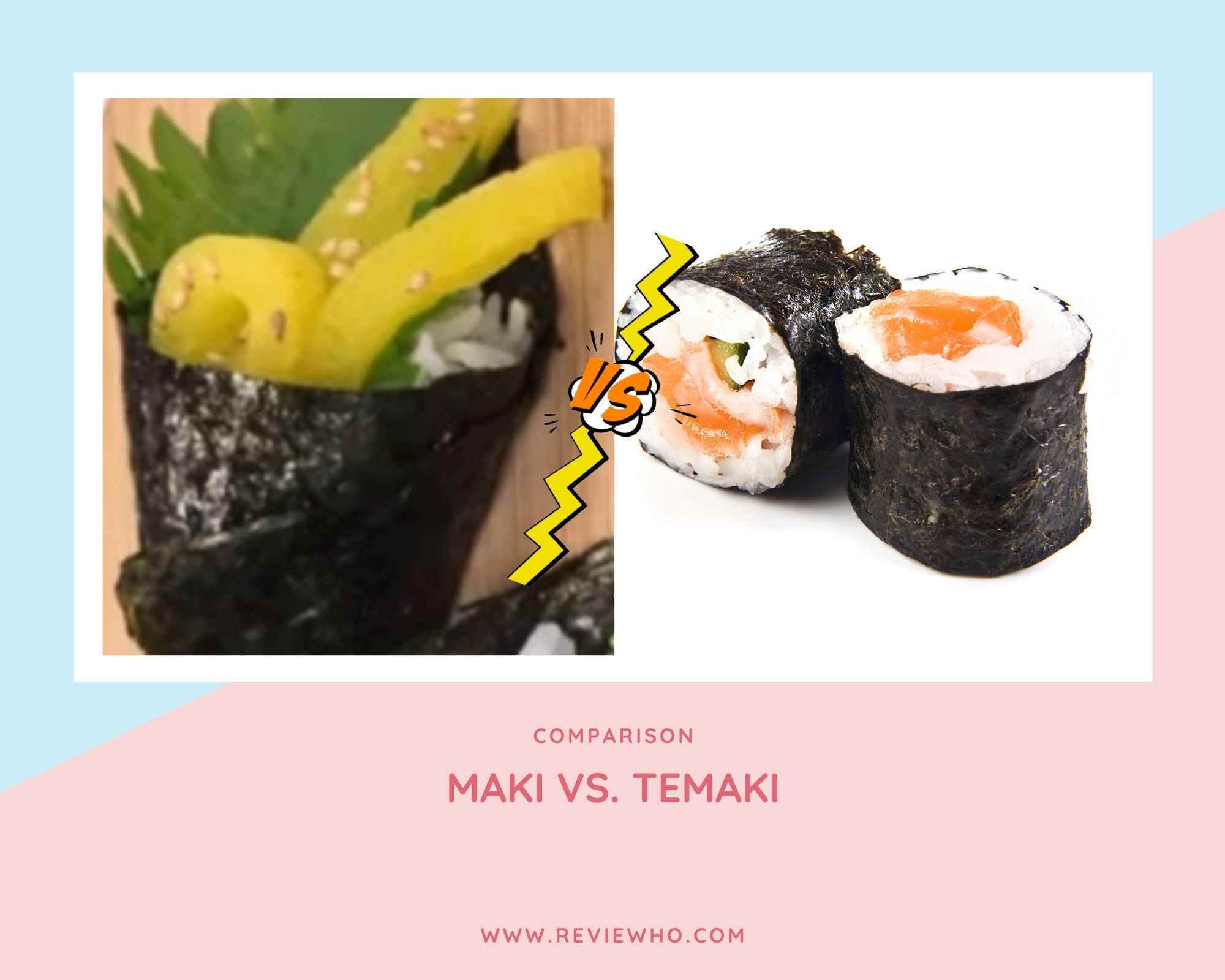Have you tried sushi before? If you did, did you like it? If you like sushi, there is probably some confusion in your mind about the different types available out there in restaurants. Two of the most confusing for sushi lovers are maki and temaki. You might be wondering about the maki vs. temaki differences, which is something we all go through after discovering the delicacies.
We prepared this post to help you identify the main temaki vs. maki differences and help you tell them apart. Maki and temaki are equally popular and you must tell them apart for future reference.
Let’s dig into it.
General Overview
What do maki and temaki mean?
The first thing you should know is that these are both Japanese-type sushi that has similar flavors.
In Japanese, Maki roll is known as Makizushi. Maki means coiling or wrapping. Maki is mainly made with fish, seaweed paper, and vegetables. You can find two types of maki roll, the Hosomaki, and the Futomaki. They differ in the width.
Temaki is called temaki zushi. The “te” in temaki means hand, which translates the entire name to hand roll sushi. When making a temaki roll, you will need a rectangular sheet instead of a square one.
One of the main differences you will notice is that maki is a sushi roll, the one you see in restaurants all the time. It is in form of a cylinder that is cut into several pieces, usually eight or even six.
Temaki, on the other hand, is a cone. The ingredients used are similar in both maki and temaki but temaki is just for a single person.
You can share a maki easily but not a temaki, even though it is larger.
As we consider the maki vs. temaki roll similarities, we should talk about the nori sheets that are used to make both of them. However, temaki tends to absorb moisture faster. Therefore, it should be eaten immediately after being rolled. Unlike the maki rolls that can sit for a while before being eaten.
Rolling a maki requires more skill. You have to know how the ingredients will be layered. You also need to know how tight the roll needs to be and how you will get a clean cut. A temaki, unlike a maki, can be done by a beginner without posing a challenge. A child can make it for a fun snack.
We will now go into more detail and discover exactly how much they differ from each other.
Shape
The easiest way to tell these apart is the shape. As we have mentioned, maki is cylindrical and is cut into pieces, normally around 8 or 6. It is similar to a Swiss roll.
Temaki has a different shape, probably because the rice has to be spread differently. You have to spread the side on a side, add the toppings you desire, and then roll it into a cone. In the end, after rolling carefully, it appears as an ice cream cone, only flat.
Ease of Preparation
Another great maki vs. temaki difference is the level of skill you need to prepare.
Temaki is not challenging at all. A child or beginner can prepare it without a problem. That means that making a temaki roll at home is easier than a maki roll. You will indeed need a bit of attention and dexterity but it maki rolls will need more than that. As long as there is adequate supervision and necessary ingredients in your house, you can allow your kids to prepare a sushi meal.
A temaki roll requires a small nori sheet. Therefore, you can split a single sheet in two and enjoy two temaki rolls.
How do you make it? It is quite simple. You simply need to place a sheet on a plate and add some rice to it. Spread that rice evenly but not on all sides. One side needs to be empty. You can then add some toppings or fillings at the center of the rice. Choose any fillings you would prefer. Finally, you have to roll the nori sheet starting with the side with rice roll the plain nori last so that the cone is sealed.
It might be wonky depending on the way you have prepared it but it is alright long as the bottom part is closed off and sharp to make sure the rice does not fall.
When it comes to maki, however, the number of toppings and rice you add has to be measured properly. If you overfill it, you might find it challenging to roll it evenly. Cutting through it might also be a challenge if you do not get it right.
What about the Fillings and Toppings?
You might be wondering if you need to use a specific type of topping or stuffing for either of these. On most occasions, people prefer to use nori, rice, or some fish, probably salmon or tuna. These are simple but quite popular.
With that said, you can adjust the ingredients however you want. There are different preferences and preparation methods in restaurants. Each restaurant will allow you to choose from a range of filling. There are vegan options too.
What are the Similarities?
There are several ways in which these two are similar. For instance, they are both wrapped in a thin seaweed wrapper known as nori. Additionally, they are made using rice as the main ingredient.
These are meals full of nutrients and can be enjoyed either as the main meal or as appetizers.
These are sushi types that you cannot go wrong with. It is a great choice for an elegant event.
Conclusion
You cannot go wrong with either of these. They are both very tasty and they have adequate nutrients to enjoy as a meal of their own. As you can tell, they are quite similar in regards to their ingredients with the only huge differences being the skills you will need, and their shape. Try out these two today and find one with toppings that you will enjoy.
Also, read:
- Difference Between Longaniza Vs Chorizo
- Difference Between Barbacoa Vs Carnitas Chipotle
- Adobada and Al Pastor Comparison
Feel free to share your observations with me in the comments section!
Also, if you find the information in this post to be useful, be sure to share this post with your friends on Facebook, Twitter, and Pinterest!




